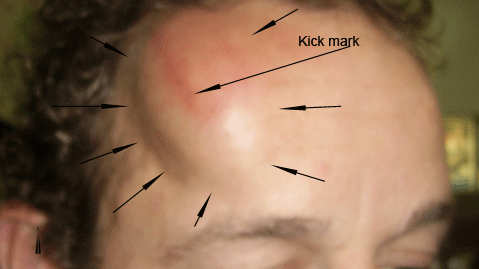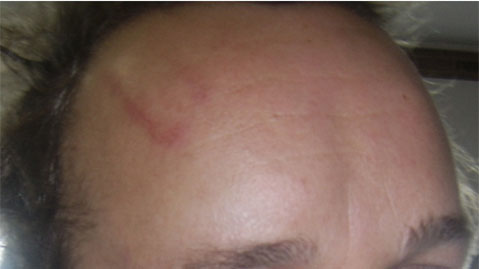How can wheatgrass be more effective than ice?
Why do so many athletes press plastic bags full of crushed ice over pulled muscles, bruises and other injuries - when the only thing it does is rapidly block blood flow to the area which is desperately needed to assist tissue recovery.
In fact, one wonders why ice is used at all. For instance, it does little to stop bleeding from the skin, nose or deeper tissues. In fact, it aggravates inflammation and swelling in the deeper tissues, slowing recovery. (1) Also, there is no fixed period for applying ice to injured areas. For instance, how long should ice be applied to help a particular injury - or should it be used at all? (2) Also, ice, ethyl chloride spray and other coolants may numb the skin and relieve pain a little, but they do little or nothing to stop bleeding or hasten recovery of damaged tissue.
By comparison, my wheatgrass extract not only reduces pain and helps stop bleeding in deep and surface tissues, it also hastens healing of damaged soft and hard tissues such as muscles and bones.
Simply, ice should not be used for treating injuries.
For example, the young man below, after being kicked on the right forehead when playing Australian football, rapidly developed a large hematoma (bruise). A wheatgrass-based cream was immediately applied to the area and stopped bleeding, enabling him to run straight back on to the field.


Initially, the swelling was very tense and blue, but when the photo on the right was taken twelve hours later, it had already softened and the dark purple-blue discoloration was no longer present. When I re-examined him the next morning, the swelling had disappeared leaving only a reddish kick mark. (Fig. 2.)
This rapid recovery was nothing new to the club’s trainer who had already seen rapid healing of soft tissue injuries such as muscular and groin strains, abrasions and blisters by the extract.
But how could such a large, tense, hematoma (bruise) “disappear” overnight? Normally, it would have taken several days at least for the bruise to flatten.
Clearly, there had been a rapid response from the wheatgrass extract for it to re-activate and open sufficient damaged blood vessels enough to enable restoration of blood flow to the injured area.
I now wince whenever I see someone apply ice to soft tissue (and bone) injuries, simply because cooling with ice does little if anything to stop bleeding under the skin, (from the nose or from deeper tissues). Apparently, ligands contained in wheatgrass extract rapidly re-activate damaged cellular receptors and restore blood flow to the injury, and healing follows.
A study by the Cleveland Clinic in the US showed that ice slows the release of a key healing substance, Insulin-like Growth Factor 1 (IGF1). This factor, an important mediator of growth hormone that helps initiate tissue repair, actually slows the healing process - but wheatgrass extract clearly accelerates it!
Clearly, ice inhibits and slows repair of injured muscles and other tissues, and should be avoided.
Armed with this information, famed American sports injury specialist, Dr. Gabe Mirkin, who formulated the RICE acronym many years ago – (Rest, Ice, Compression, Elevation) now avoids the “ICE” rule!
Swelling, pain, bleeding etc. simply should not be treated with ice, ethyl chloride spray or other coolants, because they compromise the healing efficacy of the patient's blood supply. They may numb the skin and perhaps relieve pain a little, but do nothing to assist or hasten soft tissue injury recovery. Many cultures actually use warm water compresses for treating injuries simply because the method aids blood circulation that accelerates recovery.
Any kind of injury can cause tissue damage. For instance, blood vessels rupture and blood spreads into surrounding tissues causing swelling and pain. Pressure build-up eventually reduces blood flow to muscle, nerve and other tissues which does nothing to assist tissue recovery. By comparison, wheatgrass extract does much to prevent or heal injuries by applying it lightly over both calves and thighs, before the game or training session.
How does wheatgrass extract work?
Numerous observations and scientific research suggests that ligands in wheatgrass extract bind to dysfunctional cellular receptors enabling them to notify the brain of actual injury. The brain then responds appropriately to stop bleeding, ease pain and repair other damage. Without such influence, how else could such a large hematoma (as shown in Figure 1.) disappear overnight?
Experience has also shown that the sooner wheatgrass extract is applied over the injured area, the sooner the deep and/or surface bleeding ceases and the skin and underlying tissue commences recovery.
Bloody noses, open wounds, bruises, sprained ankles, cuts, scratches, abrasions and deep tissue injuries such as corked, torn or pulled muscles all respond to wheatgrass extract treatment.
Interestingly, a summary of 22 scientific articles found almost no evidence that ice and compression can hasten healing compared with compression alone, although ice plus exercise may marginally help to heal ankle sprains (The American Journal of Sports Medicine, January, 2004;32(1):251-261).
Wheatgrass extract can do a much better job alone - and faster.
Injuries - how to hasten recovery
Any injury can cause tissue damage. For instance, blood vessels rupture so that blood spreads into surrounding tissues causing inflammation and swelling. Pressure build-up then slows muscle, nerve and other tissue recovery.
It is widely known that the most important thing to do for any injury is to stop the bleeding!
Blood in the tissues can do considerable damage and significantly slow the healing process. However, the sooner wheatgrass is applied, the sooner the deep and surface bleeding stops, swelling is reduced and blood supply is restored, with rapid recovery being the likely outcome.
Having used my wheatgrass extract since 1995 for recovering numerous sports and other injuries, I have no doubt it is a powerful hemostatic agent. That is, it stops bleeding and repairs damaged tissue quickly. Blood noses, open wounds, bruises, sprained ankles, cuts, scratches, abrasions and deep tissue injuries such as corked, torn or pulled muscles - all respond rapidly to wheatgrass extract.
Some injuries I have seen respond well to wheatgrass extract
- Pulled muscles (hamstrings, quadriceps, calf, loins, back)
- Groin injuries (osteitis pubis, adductor tendinitis)
- Blisters, abrasions, wounds, bruises, corks - can heal in a few days, not weeks. (Perfectly safe to use on open wounds.)
- Muscle cramps
- Blood rule - wheatgrass can stop bleeding quickly.
- Shin splints
- Achilles tendinitis
- Runners knee
- Sprained ankle
Reference:
MacAuley, D. Do textbooks agree on their advice on ice? Clinical Journal of Sport Medicine. 11(2):67-72, April 2001.